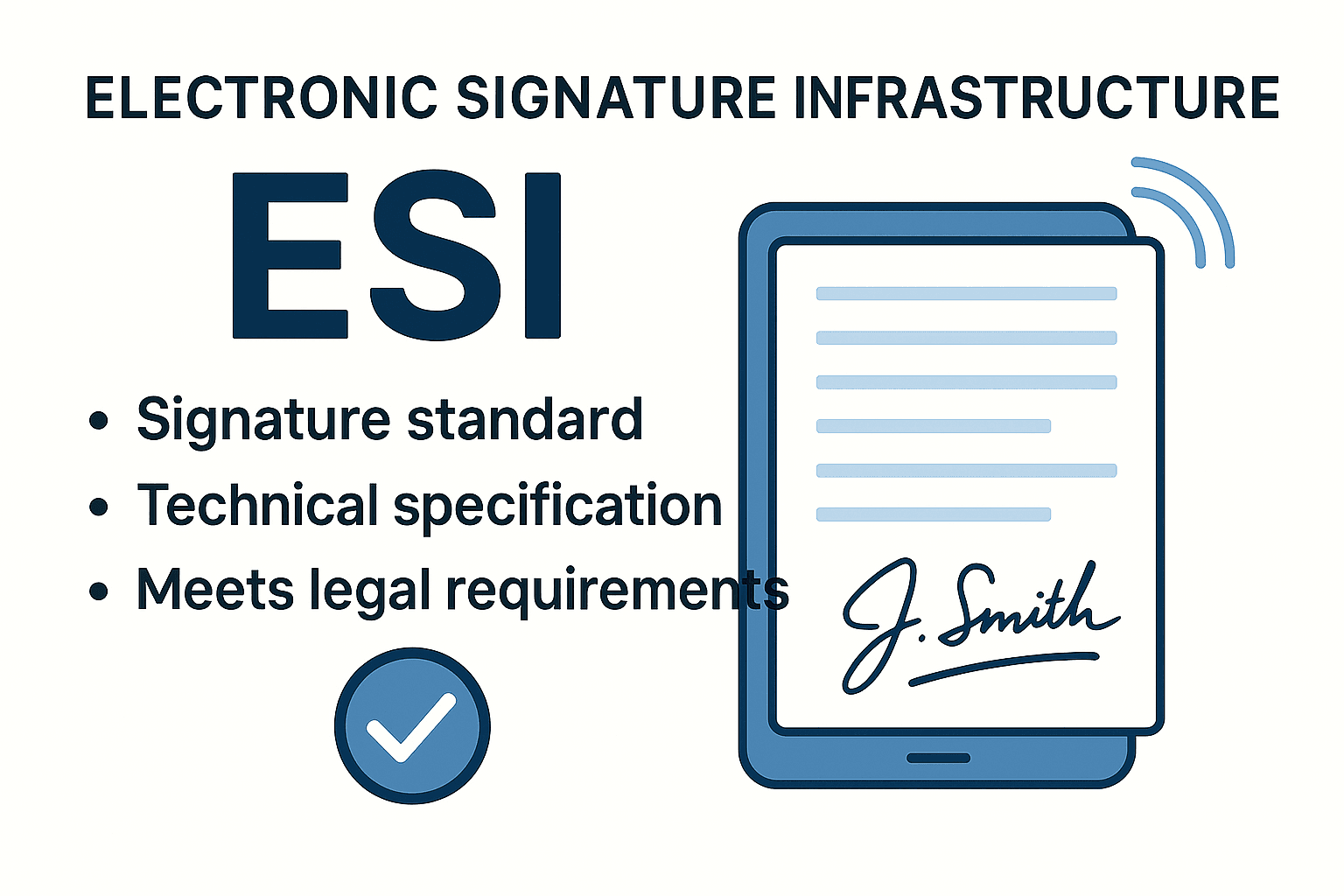WhatsApp or email with our sales team or get in touch with a business development professional in your region.
ESI (Electronic Signature Infrastructure) Explained





ESI (Electronic Signature Infrastructure) Explained: The “Notary + Stamp Factory + Archive” of the Digital World
In the digital age, electronic signatures have become an indispensable part of business and legal transactions. To ensure the authenticity, integrity, and legal validity of electronic signatures, the European Telecommunications Standards Institute (ETSI) introduced the Electronic Signature Infrastructure (ESI). ESI provides technical specifications for electronic signatures, electronic seals, and related digital services while ensuring legal protection for cross-border electronic transactions. This article will provide a comprehensive understanding of ESI, its core functions, components, and the differences between international standards and Chinese standards.

- What is ESI?
ESI (Electronic Signature Infrastructure) refers to a series of standards established by ETSI, which provide comprehensive technical specifications and frameworks for electronic signatures, timestamps, certificate services, trust services, and other digital services. The primary goal is to support the implementation of the EU eIDAS regulation (No 910/2014), ensuring the security, legality, and cross-border interoperability of electronic transactions.
1.1. A One-Sentence Definition
ESI is a combination of technology, rules, and services designed to generate, manage, and validate electronic signatures and seals, ensuring they hold the same legal value as handwritten signatures and physical stamps.

1.2. Understanding through Analogy
To better understand the role of ESI, let’s compare it to the traditional “signing and stamping” process in the physical world:
Signer: Needs to prove “I am who I say I am” (identity verification). Seal: Needs to be registered with the authorities (seal registration system). File Storage: Needs notarization to prevent tampering (evidence storage service).
ESI digitizes these processes:
Electronic Signature ≈ Your digital handwritten signature Electronic Seal ≈ Registered digital stamp Timestamp ≈ The “date stamp” of a digital notary Certificate Authority (CA) ≈ The “police station + notary” of the digital world
- Core Functions of ESI
The core function of ESI is to solve the three major trust issues in the digital world: identity trust, content integrity, and non-repudiation of actions.
2.1. Identity Trust
How to prove “who signed the document”? This is achieved through digital certificates (similar to digital ID cards) binding the signer’s identity. For example, when signing an electronic contract with a bank, the system will require you to first undergo real-name authentication (facial recognition/SMS verification) and then issue a digital certificate.
2.2. Content Integrity
How to prove “the document has not been tampered with”? ESI uses cryptographic algorithms (such as SM3 hash or SHA256) to generate a “digital fingerprint” of the document. Any alteration will cause a mismatch in the fingerprint, ensuring the integrity of the document.
2.3. Non-repudiation of Actions
How to prove “you actually signed”? By adding a timestamp and logging the action when signing, it ensures that the signer cannot later deny the signing event.
- Components of ESI: Four Core Modules
ESI is not a single technology but rather an “ecosystem” consisting of the following four core modules:
3.1. Electronic Signature/Seal Standards
International Standards: ETSI has developed standards such as CAdES (electronic signatures), XAdES (XML signatures), and PAdES (PDF signatures). Chinese Standards: The corresponding domestic standards include GB/T 38540 (electronic seals) and GM/T 0031 (security electronic signature cryptographic standards).
3.2. Public Key Infrastructure (PKI)
CA (Certificate Authority): Responsible for issuing and managing digital certificates (e.g., CFCA, Shanghai CA). Timestamping Services (TSA): Add timestamps to signatures to prevent tampering with signing dates. Certificate Revocation Lists (CRL/OCSP): Real-time checks to determine if certificates have been revoked (for example, an employee’s certificate must be invalidated when they leave the company).
3.3. Electronic Signature/Seal Application Systems
Signing Software: Software such as Adobe Acrobat (supporting PAdES), Docusign, or domestic systems like eSignGlobal. Verification Tools: The same signing tools can often be used to verify the authenticity of signatures.
3.4. Legal and Compliance Framework
International Regulations: These include the EU eIDAS regulation, the US ESIGN Act, etc. Chinese Regulations: These include the People’s Republic of China Electronic Signature Law, People’s Republic of China Cryptography Law, and mandatory use of domestic cryptographic algorithms (e.g., SM2/SM3).
- ESI vs Chinese Standards (GB/T 38540)
While Chinese standards like GB/T 38540 are localized versions of ESI, there are some key differences in terms of technical implementation and compliance requirements.
Similarities
Both address the issues of “identity authentication + tamper-proofing + non-repudiation.” Both rely on the PKI system (CA certificates + timestamps).
Differences
Algorithms: International ESI uses internationally recognized algorithms (such as RSA, SHA-256), while Chinese standards mandate the use of domestic cryptographic algorithms (such as SM2/SM3). Seal Form: International ESI focuses more on “signature data” and does not mandate a specific visual seal, while Chinese standards regulate the format of the seal image (e.g., BMP/PNG) and require it to be bound to the signature data. Compliance: International ESI must comply with regulations like eIDAS, while Chinese standards must adhere to the Electronic Signature Law, with commercial cryptographic certification and licensed CAs (e.g., Ministry of Industry and Information Technology license).
- Conclusion
Electronic Signature Infrastructure (ESI) is a comprehensive system combining technology, legal frameworks, and services, designed to ensure the trustworthiness and legality of electronic transactions. As the global digital economy continues to expand, ESI is becoming an essential foundation for cross-border electronic transactions. With continuous development of both international and Chinese standards, electronic signature technologies will become more efficient, user-friendly, and secure.
In next article, we will dive deeper into the PAdES standard and explore how it further enhances the legal effectiveness of electronic signatures. Stay tuned!
Appendix:
ETSI EN 319 102: Signature Creation and Validation Process, defines how to securely generate and validate advanced signatures. ETSI TS 119 100: The Framework for Standardization of Digital Signatures and Trust Services, describes the framework for standardizing digital signatures and trust services.

HaiYang
Product Manager, a seasoned leader with extensive international experience in the e-signature industry.
Follow me on LinkedIn
Get legally-binding eSignatures now!
30 days free fully feature trial
Business Email
Get Started
 Only business email allowed
Only business email allowed


